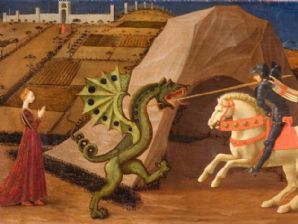Paolo Uccello. St George and the Dragon. From the Musée Jacquemart-André, Paris

On 14 April 2019, the State Hermitage opened the latest exhibition in the "Masterpieces from the World's Museums in the Hermitage" series - "Paolo Uccello. St George and the Dragon. From the Musée Jacquemart-André, Paris".
Florentine art of the 15th-century has a wealth of splendid masters who are dissimilar from each other in their searchings and achievements, while seeking to authentically reproduce the real world around them. Among this constellation of brilliant artists of the Quattrocento who laid the foundations for the art that we term realistic, Uccello (Paolo di Dono, 1397-1475) holds a place of honour.
Like many painters of his time, Uccello came from the milieu of craftsmen: his father was a barber-surgeon, while his mother belonged to a quite prominent Florentine family. Paolo got his initial artistic training from the sculptor Lorenzo Ghiberti.
Uccello was one of the first Florentine artists in whose work the laws of linear perspective became a central element. In the new understanding of the material world and its reflection in art, perspective played a very important role. It was called upon to overcome the lack of depth in mediaeval icons by depicting the space presented in a picture in the way that people actually perceive it.
Many of the painter's works, which are marked by a rich imagination, display a refined decorativeness and colourfulness. Artistic devices in keeping with the demands of the realism of the new era combine in his work with an unconscious nostalgia for the bygone age of chivalry and that disappearing world acquires new life and colour in the fabulous verisimilitude of this master's pictures.
The painting of St George and the Dragon conveys the viewer into a courtly tale of chivalrous deeds: a bold knight defeats a dragon, striking an overwhelming blow, and saves a beautiful princess, who watches as the daring champion runs the monster through. The young kinswomen who accompanied the unfortune sacrifice are returning on the road to the city. At the end, they turn around for a last look at her and become witnesses to her miraculous deliverance. The surrounding landscape would, one might think, help the artist to construct a space running away into the depths, converging at a single point on the horizon, but unexpectedly here we also encounter reverse perspective, when the lines converge at the position of the viewer, as happens with mediaeval icons.
The artist devoted great attention to details of the knight's armour, the princess's clothing and the horse's fancy red and gold harness.
One cannot help but be enchanted by this magical scene in which, inevitably, good triumphs over evil.
* * * The Musée Jacquemart-André
The museum was named after its founders, the married couple Edouard André and Nélie Jacquemart. Edouard André (1833-1894) came from a wealthy banking family that provided support to Napoleon III during the Second Empire. Withdrawing from politics, Edouard devoted himself completely to art collecting that was his passion since his youth. In the late 1860s, to accommodate the many diverse objects in his collection, he commissioned the design of a magnificent mansion from the architect Henri Parent. Inspired by 18th-century architecture, Parent created a building remarkable for its luxurious pomp. The celebration of its opening in 1876 became a notable event in Parisian social life. In 1881, Edouard André married Cornélie (Nélie) Jacquemart (1841-1912), who complete shared her husband's interests and his fascination with art.
The Musée Jacquemart-André possesses a large collection of European paintings, including works by such outstanding figures as Rembrandt, Hals, Van Dyck, Chardin and Fragonard. It also presents sculpture and applied art. The museum takes particular pride in its stocks of Italian 14th-16th-century paintings: the Jacquemart-André collection is as rich as those of some famous museums.
The exhibition curator is Tatiana Kirillovna Kustodieva, Candidate of Art Studies, leading researcher in the State Hermitage's Department of Western European Fine Art.